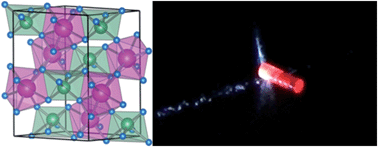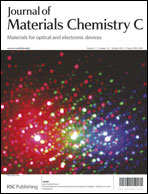Optical and dielectric behaviour of EuNbO4 crystals
Abstract
In this work, EuNbO4 samples were prepared, in the shape of fibres, by the laser floating zone (LFZ) technique. The fibres grown at pulling rates below 20 mm h−1 are transparent and monophasic, crystallizing in a monoclinic structure. At higher growth rates, non-stoichiometric europium orthoniobate phases were promoted. The physical properties analysed in this work were the electric, dielectric and photoluminescence (PL) properties. For the fibre grown at 2.5 mm h−1, the dc conductivity shows a value of 5.97 × 10−12 S m−1 and the ac conductivity, at 1 MHz and 300 K, is 3.08 × 10−4 S m−1. Under the same experimental conditions the dielectric constant is ∼39 and the loss tangent ∼0.14, also presenting a relaxation phenomenon centred at ∼120 kHz. An ionic polarization type behaviour was identified from the dielectric measurements, which justifies the temperature independent behaviour of the dielectric constant. This type of polarization was assigned to the NbO4 units. PL measurements with ultraviolet excitation reveal the intra-4f6 transitions of Eu3+ ions in the fibres, exhibiting narrow intraionic lines as expected for single crystal materials. From the PL spectra at low temperature, it was possible to identify multiple europium related centres, from different local site symmetry and/or environment. The luminescence of Eu3+ was found to be preferentially excited via a broad excitation band peaked at ∼280 nm.


 Please wait while we load your content...
Please wait while we load your content...